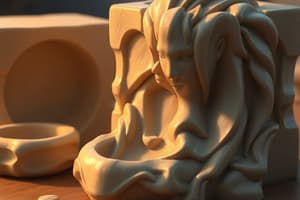Podcast
Questions and Answers
In expendable mold casting, the mold must be destroyed to remove the casting.
In expendable mold casting, the mold must be destroyed to remove the casting.
True (A)
Sand casting is an example of a permanent mold casting process.
Sand casting is an example of a permanent mold casting process.
False (B)
Permanent molds are made of materials like sand and plaster.
Permanent molds are made of materials like sand and plaster.
False (B)
Die casting involves molds that need to be destroyed after casting removal.
Die casting involves molds that need to be destroyed after casting removal.
Expendable mold processes allow for more complex casting geometries compared to permanent mold processes.
Expendable mold processes allow for more complex casting geometries compared to permanent mold processes.
Permanent molds consist of sections that cannot be opened for part removal.
Permanent molds consist of sections that cannot be opened for part removal.
Sand casting is the most widely used casting process.
Sand casting is the most widely used casting process.
Sand casting can be used for metals with high melting temperatures, such as steels, nickels, and titaniums.
Sand casting can be used for metals with high melting temperatures, such as steels, nickels, and titaniums.
The cavity in the sand mold is formed by pouring molten metal directly into the sand.
The cavity in the sand mold is formed by pouring molten metal directly into the sand.
The same sand mold can be reused multiple times for producing the same part.
The same sand mold can be reused multiple times for producing the same part.
Sand casting can be used to produce parts ranging in size from small to very large.
Sand casting can be used to produce parts ranging in size from small to very large.
The gating and riser system is not part of the sand mold in sand casting.
The gating and riser system is not part of the sand mold in sand casting.
Holes in the plate allow the top and bottom (cope and drag) sections of the mold to be aligned accurately.
Holes in the plate allow the top and bottom (cope and drag) sections of the mold to be aligned accurately.
Part (d) of the figure includes the gating and riser system in the cope-and-drag patterns.
Part (d) of the figure includes the gating and riser system in the cope-and-drag patterns.
Patterns define the internal surfaces of the cast part.
Patterns define the internal surfaces of the cast part.
A core is a full-scale model of the external surfaces of the part.
A core is a full-scale model of the external surfaces of the part.
Chaplets are made of a metal with a lower melting temperature than the casting metal.
Chaplets are made of a metal with a lower melting temperature than the casting metal.
The portion of the chaplet protruding from the casting is left intact after solidification.
The portion of the chaplet protruding from the casting is left intact after solidification.
Moisture in the sand can cause defects in some castings.
Moisture in the sand can cause defects in some castings.
Dry-sand molds are made using clay binders.
Dry-sand molds are made using clay binders.
Oven baking of dry-sand molds strengthens the mold and hardens the cavity surface.
Oven baking of dry-sand molds strengthens the mold and hardens the cavity surface.
Dry-sand molding provides better dimensional control than green-sand molding.
Dry-sand molding provides better dimensional control than green-sand molding.
Dry-sand molding has a higher production rate than green-sand molding.
Dry-sand molding has a higher production rate than green-sand molding.
In a skin-dried mold, the entire mold is dried, not just the surface.
In a skin-dried mold, the entire mold is dried, not just the surface.
Hand ramming is the most complex method of packing sand molds.
Hand ramming is the most complex method of packing sand molds.
Green-sand molds possess sufficient strength for most applications.
Green-sand molds possess sufficient strength for most applications.
Dry-sand molds have better collapsibility than green-sand molds.
Dry-sand molds have better collapsibility than green-sand molds.
Permeability refers to the mold's ability to resist cracking and buckling upon contact with molten metal.
Permeability refers to the mold's ability to resist cracking and buckling upon contact with molten metal.
Green-sand molds are the most widely used mold type.
Green-sand molds are the most widely used mold type.
Sand casting is an example of an expendable mold casting process.
Sand casting is an example of an expendable mold casting process.
Flashcards are hidden until you start studying




